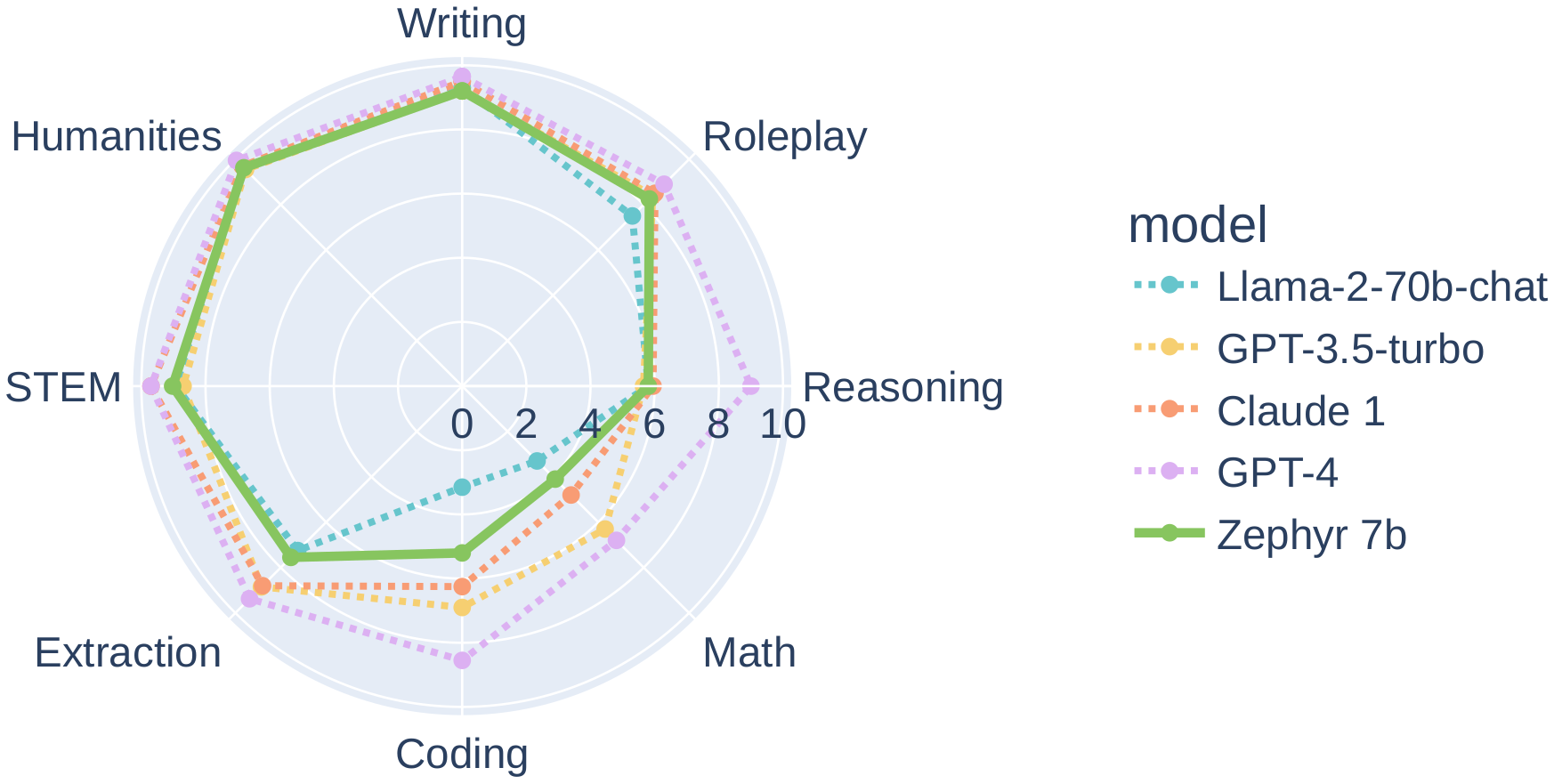license: mit
base_model: HuggingFaceH4/zephyr-7b-gemma-sft
tags:
- alignment-handbook
- trl
- dpo
- generated_from_trainer
datasets:
- argilla/dpo-mix-7k
pipeline_tag: text-generation
model-index:
- name: zephyr-7b-gemma
results:
- task:
type: text-generation
name: Text Generation
dataset:
name: MT-Bench
type: unknown
metrics:
- type: unknown
name: score
value: 7.81
source:
url: https://huggingface.co/spaces/lmsys/mt-bench

Model Card for Zephyr 7B Gemma
Zephyr is a series of language models that are trained to act as helpful assistants. Zephyr 7B Gemma is the third model in the series, and is a fine-tuned version of google/gemma-7b that was trained on on a mix of publicly available, synthetic datasets using Direct Preference Optimization (DPO). You can reproduce the training of this model via the recipe provided in the Alignment Handbook.
Model description
- Model type: A 7B parameter GPT-like model fine-tuned on a mix of publicly available, synthetic datasets.
- Language(s) (NLP): Primarily English
- License: MIT
- Finetuned from model: google/gemma-7b
Model Sources
- Repository: https://github.com/huggingface/alignment-handbook
- Demo: https://huggingface.co/spaces/HuggingFaceH4/zephyr-chat
Performance
At the time of release, Zephyr 7B Gemma is the highest ranked 7B chat model on the MT-Bench and AlpacaEval benchmarks:
In particular, on several categories of MT-Bench, Zephyρ 7B Gemma has strong performance compared to larger open models like Llama2-Chat-70B:
However, on more complex tasks like coding and mathematics, Zephyr 7B Gemma lags behind proprietary models and more research is needed to close the gap.
Intended uses & limitations
The model was initially fine-tuned on the DEITA 10K dataset, which contains a diverse range of synthetic dialogues generated by ChatGPT.
We then further aligned the model with 🤗 TRL's DPOTrainer on the argilla/dpo-mix-7k dataset, which contains 7k prompts and model completions that are ranked by GPT-4. As a result, the model can be used for chat and you can check out our demo to test its capabilities.
Here's how you can run the model using the pipeline() function from 🤗 Transformers:
# Install transformers from source - only needed for versions <= v4.38.1
# pip install git+https://github.com/huggingface/transformers.git
# pip install accelerate
import torch
from transformers import pipeline
pipe = pipeline(
"text-generation",
model="HuggingFaceH4/zephyr-7b-gemma",
device_map="auto",
torch_dtype=torch.bfloat16,
)
messages = [
{
"role": "system",
"content": "", # Model not yet trained for follow this
},
{"role": "user", "content": "How many helicopters can a human eat in one sitting?"},
]
outputs = pipe(
messages,
max_new_tokens=128,
do_sample=True,
temperature=0.7,
top_k=50,
top_p=0.95,
stop_sequence="<|im_end|>",
)
print(outputs[0]["generated_text"][-1]["content"])
# It is not possible for a human to eat a helicopter in one sitting, as a
# helicopter is a large and inedible machine. Helicopters are made of metal,
# plastic, and other materials that are not meant to be consumed by humans.
# Eating a helicopter would be extremely dangerous and would likely cause
# serious health problems, including choking, suffocation, and poisoning. It is
# important to only eat food that is safe and intended for human consumption.
Bias, Risks, and Limitations
Zephyr 7B Gemma has not been aligned to human preferences for safety within the RLHF phase or deployed with in-the-loop filtering of responses like ChatGPT, so the model can produce problematic outputs (especially when prompted to do so). It is also unknown what the size and composition of the corpus was used to train the base model (google/gemma-7b), however it is likely to have included a mix of Web data and technical sources like books and code. See the StarCoder2 model card for an example of this.
Training and evaluation data
This model is a fine-tuned version of HuggingFaceH4/zephyr-7b-gemma-sft on the argilla/dpo-mix-7k dataset.
It achieves the following results on the evaluation set:
- Loss: 0.4695
- Rewards/chosen: -3.3746
- Rewards/rejected: -4.9715
- Rewards/accuracies: 0.7188
- Rewards/margins: 1.5970
- Logps/rejected: -459.4853
- Logps/chosen: -429.9115
- Logits/rejected: 86.4684
- Logits/chosen: 92.8200
Training hyperparameters
The following hyperparameters were used during training:
- learning_rate: 5e-07
- train_batch_size: 2
- eval_batch_size: 4
- seed: 42
- distributed_type: multi-GPU
- num_devices: 8
- gradient_accumulation_steps: 8
- total_train_batch_size: 128
- total_eval_batch_size: 32
- optimizer: Adam with betas=(0.9,0.999) and epsilon=1e-08
- lr_scheduler_type: cosine
- lr_scheduler_warmup_ratio: 0.1
- num_epochs: 2
Training results
| Training Loss | Epoch | Step | Validation Loss | Rewards/chosen | Rewards/rejected | Rewards/accuracies | Rewards/margins | Logps/rejected | Logps/chosen | Logits/rejected | Logits/chosen |
|---|---|---|---|---|---|---|---|---|---|---|---|
| 0.1923 | 1.9 | 100 | 0.4736 | -3.4575 | -4.9556 | 0.75 | 1.4980 | -459.1662 | -431.5707 | 86.3863 | 92.7360 |
Framework versions
- Transformers 4.39.0.dev0
- Pytorch 2.1.2+cu121
- Datasets 2.14.6
- Tokenizers 0.15.1
